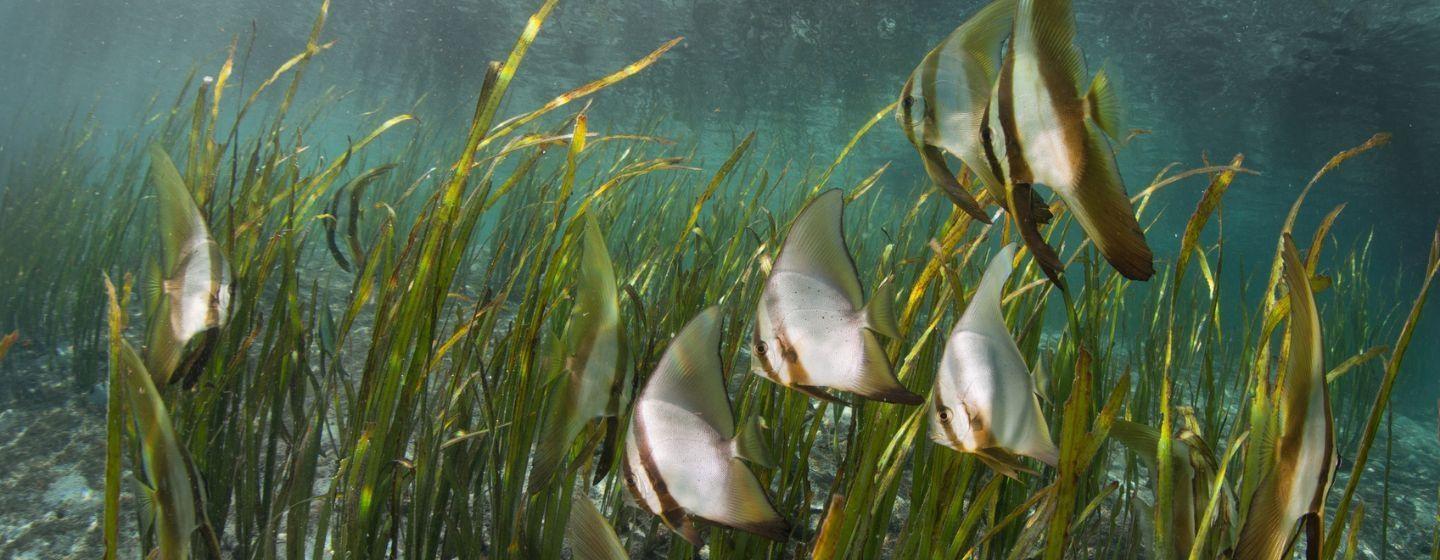A New Approach to Restoring Vital Coastal Seagrass


Depending on who you talk to, seagrass is many things.
Seagrass can be a nuisance that ties up your boat’s propeller or gets stuck in the toehold of your flip-flop. At other times, seagrass can be a mesmerizing sight as it waves back and forth in the current just under the surface.
But to coastal scientists, seagrasses are much more complex. The underwater lawns provide habitat and nurseries for dozens of fish and crustacean species, help improve water quality by filtering sediments from the water and provide protection from storms and sea level rise by stabilizing the coastline.
Oh yes, seagrass is also a food source for some species, including sea turtles. Plus, it sequesters carbon from the atmosphere to help fight climate change.
You get the idea. Seagrasses can be seen as good or bad in the moment, but they are essential for a healthy coast.
“It’s an old saying, but if you want a good fishing spot, you find seagrass,” said Jessie Jarvis, Ph.D., a coastal plant ecologist and associate professor in the Department of Biology and Marine Biology at UNC Wilmington (UNCW). “However, some seagrass meadows are disappearing, and it’s a trend we don’t want to see continue.”
Scientists say two things are killing seagrass.
First is warm water. A check of daily ocean temperatures shows that average water temperatures have been increasing. You can blame climate change.
Second, declining water quality means less sunlight is reaching the seagrass. Seagrass uses photosynthesis to make food, just like any other plant.
Those factors combined means North Carolina’s seagrass beds are declining at an estimated rate of 1 to 2 % per year.
That’s bad, but it’s a lot worse just to our north in the Chesapeake Bay in Virginia. Seagrass meadows there have declined by 38%. Some areas are barren. Researchers worry that could happen here.
But here’s the thing; some seagrasses in North Carolina seem to be adapting better to temperature stress than other populations along the East Coast.
In fact, there are pockets of seagrass in Back Sound, which runs from Cape Lookout National Seashore to Beaufort Inlet, that appear to be stable. Nobody knows why.
“In the past, seagrass research has focused on trends and whether seagrass is healthy and increasing or if it’s decreasing,” adds Jarvis. “We need to look at healthy populations and figure out the mechanisms of this resilience, then we can see about preemptively building that resilience into other populations.”
Seagrass is found in North Carolina’s huge sounds and on the shores along the Outer Banks. When all of that is added up, North Carolina has the second largest seagrass resource on the East Coast. Florida has the most seagrass.
There are three species of seagrass found in North Carolina’s estuaries: eelgrass (Zostera marina), shoal grass (Halodule wrightii) and widgeon grass (Ruppia maritima).
It’s the eelgrass that is in decline but not everywhere.
“We’re finding pockets of eelgrass that are able to resist the high temperatures that they’re experiencing, and we’re not sure why,” said Stephanie Kamel, associate professor in the Department of Marine Sciences at the UNCW. “But with water temperatures continuing to rise and coastal development expected to continue, seagrass beds will continue to be stressed, so we’ve got to figure out what makes these seagrass pockets stronger.”
The new approach to seagrass has researchers collecting seeds from areas where seagrasses appear to be adapting and then test the genetics of the seeds.
The seeds will then be replanted. Seeds from Virginia will be planted in North Carolina, and seeds from North Carolina will be planted in Virginia.
Samples from the most promising sites will be tested in restoration sites. Once the seeds are planted, their growth will be monitored. The information will help with future restoration plans.
“The goal is to shift from taking seeds and replanting shoots and hoping for the best to a more targeted plan using plants that are better suited for a changing climate, “said Kamel.
“We need to do something different because what we’re doing now to restore seagrass populations isn’t working,” adds Kamel.